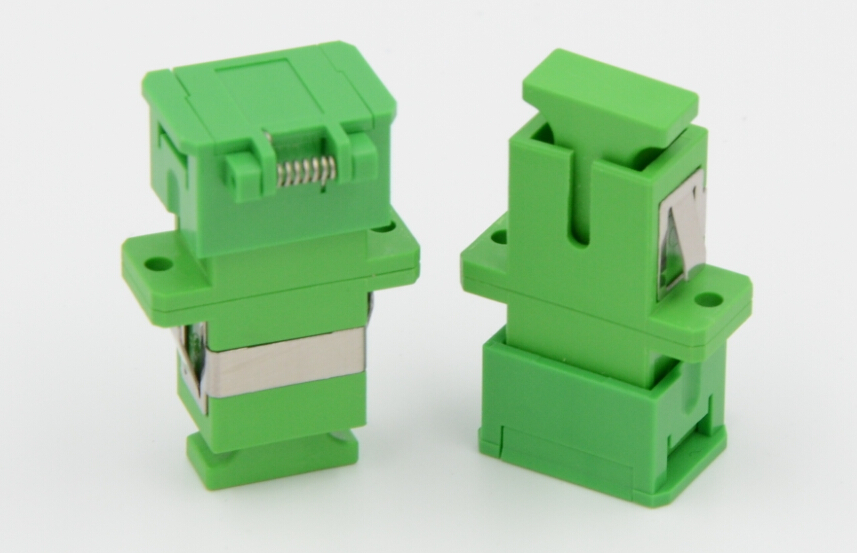/ From: / Review:1474
How to connect two fiber patch cables together? The answer is fiber optic adapter. Fiber optic adapter is designed to mate or connect two fiber cables with high precision. The connection is achieved by fitting the connectors of two separate fiber cables ends into two slots opposite each other of the adapter. Through the alignment, signal loss can be reduced to a minimum. Fiber optic adapter is a small but critical equipment in an optical fiber cabling system.
Fiber Optic Adapter Basics
There are simplex and duplex fiber optic adapters, sometimes four fibers together (quad). They are designed for single-mode and multimode cables. Single-mode adapters offer more precise alignment of the tips of the ferrules. When connecting two multimode fibers, make sure the two fibers have the same core diameter (50/125 or 62.5/125) to avoid mismatch. We often see the two fiber assemblies connected have the same fiber connectors, such as LC-LC, SC-SC, etc. Then it’s often called coupler (non-hybrid adapter).

However, as people continue to add new connectors to their installation yet maintain the same hardware and equipment, non-hybrid adapters can’t meet the demand. So the use of hybrid adapters which connect different types of connectors keeps increasing. Hybrid adapters include various categories, like LC-SC, ST to SC, LC-ST, and so on. Hybrid adapters are more expensive. As different connectors have different ferrule sizes, for instance, LC-SC fiber optic adapter (1.25mm to 2.5mm), the manufacturing process of this kind of adapters will be more complicated.
Adapter Alignment Sleeve
Two copper conductors can be joined directly by connectors that have been crimped to the wires. Different from copper cable connection, fiber optic cable connection is more complicated and it requires highly precise alignment. And the alignment needs two precision components: the ferrule within each connector and the alignment sleeve within each adapter.
Inside a connector, the ferrule is to secure and align the fiber. And in an adapter, the alignment sleeve is designed to mate the ferrules of two connectors within the adapter’s sleeve at its approximate midpoint. The alignment sleeve of the adapter is critical to the accurate fiber cable connection. Otherwise, no matter how precise the ferrules are, the optical network link can’t operate so well.
Adapter Alignment Sleeve Materials
The alignment sleeve is the most important component of a fiber optic adapter. The materials of the sleeve can be metal, ceramic and polymer. The following will introduce each material. Then you will know which kind of adapter you need.
Metal
Metal sleeve are made of two metal alloys, phosphorous bronze (PB) and beryllium copper (BC). PB is the most commonly used. Fiber optic adapters with PB sleeve are mostly made in Japan. The manufacturing process has to deal with the key parameters of the sleeve carefully.
Ceramic
Ceramic (zirconia) is also used as the alignment sleeve material of adapter. Ceramic is thought to be easily cracking in the field. Actually ceramic ferrule is good to offer high precision mating and reduce insertion loss during optical signal transmission.
Polymer
Polymer is a new materials used to produce ferrule. Polymer is as strong as metal. However, sleeves made of polymer can’t deliver optical performance as good as metal or ceramic. Tests show that the insertion loss caused by a polymer sleeve is more than 0.2 dB and it gets worse after repeated mating and unmating cycles. It’s only used for connecting multimode connectors because it’s difficult to get high performance by polymer in single-mode applications.
Sometimes you may feel confused about the adapters made of three materials. Metal sleeves are more durable but the precision is not as good as ceramic. So adapters made of metal sleeves are usually used in multimode applications where precision alignment is not so vital. Ceramic ferrules can offer you precise alignment but the service life is shorter. Polymer adapters are the least expensive among the three kinds. So if you have tight budget, adapters with polymer sleeves are your first choice. On the contrary, cost is beyond your consideration, you can choose adapters with metal or ceramic materials.
Fiber Optic Adapter Improvement
Cleaning issue is always an important consideration of fiber optic connection. When mating and unmating adapters repeatedly, it becomes more important to keep fiber optic adapter clean and free of debris. To solve this trouble, the adapter is specially designed with a dust cover or shutter, eg. SC duplex adapter (as shown in the following figure). This design can keep dust and grime from getting into the interconnection system.

Summary
Fiber optic adapters provide a cable to cable or cable to equipment fiber optic connection. Gelink supplies a wide range of couplers and hybrid adapters, including simplex or duplex, single-mode or multimode, metal or ceramic. For more information about Gelink adapter solutions, please contact us via sales@gelink.com.cn